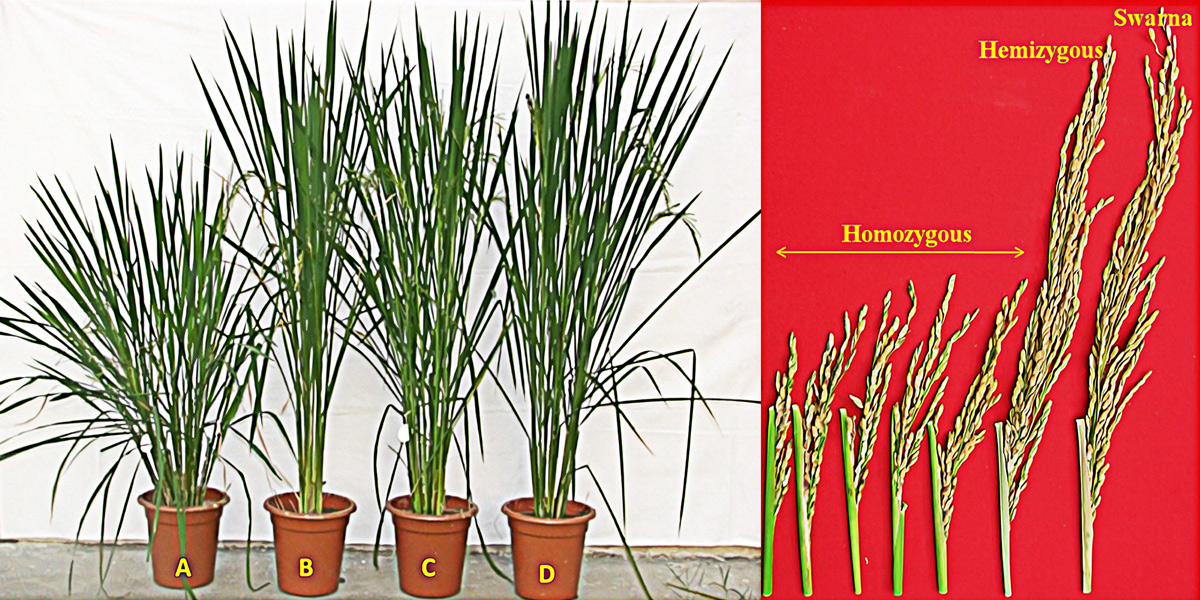
Unintended effects of GM process burst hype bubble
A new study reports unintended effects in GM golden rice, which is engineered to produce precursors of vitamin A called carotenoids. Crossing the GM rice with the Indian variety Swarna, a step necessary for commercialization, led to a nasty surprise. The resulting plants were stunted, showed extensive abnormalities in their growth, and had reduced grain yield, as compared with the non-GM Swarna variety.
The researchers identified several reasons for the unexpected effects – the new gene constructs interfered with the plant’s own gene for producing growth hormones, and the additional gene constructs were not, as intended, active solely in the kernels, but also in the leaves. This led to a substantial reduction in the content of chlorophyll that is essential for vital functions in the plants.
These unintended effects were not detected in previous investigations, and it was assumed that the genetically engineered plants used in these trials would show genetic stability. In fact, these detrimental genomic effects remained undetected until the transgenic plants were crossed with the variety called Swarna, which is grown widely in India.
London-based molecular geneticist Dr Michael Antoniou commented on the new findings: “I have always asserted that the GM transformation process as used in the development of GMO crops selects for the insertion of the GM gene into active regions of the genome (areas where plant host genes are switched on and functioning). This bias in the GM gene insertion into active regions therefore maximises the possibility of disrupting the function of one or more host genes, with potentially adverse effects such as poor crop performance or even toxicity.
“This latest finding of the GM gene insertion into a vital host gene in the golden rice is a graphic illustration of this principle. If the developers of golden rice had conducted a proper molecular characterisation of this GM event at the time it was generated, they would have identified the host gene disruption that led to the stunted and deformed growth of the rice plants. Then they could potentially have avoided this negative outcome at such a late stage in the development and release of golden rice. Now it’s back to square one, with years of research work and millions of dollars wasted.”
GM golden rice is much hyped by GMO proponents as a triumph of GM that will save people in the third world from nutritional deficiencies and vitamin A deficiency-related blindness. The new study casts doubt on the viability of the golden rice project, which has produced nothing of value despite years of misplaced hype. In contrast, common-sense approaches to combating vitamin A deficiency are working in the Philippines, the country targeted for GMO golden rice release – they just need to be rolled out more widely.
Failed golden rice could endanger whole rice harvest
The new findings are highly relevant for the risk assessment of the plants. Once released, the transgenic plants could spread their gene constructs into populations of weedy rice as well as other cultivated varieties. In addition, genomic effects not found in the original plants can occur in plant offspring. At the stage when the hazards are identified, it can be impossible to remove the transgenes from the environment.
“Instead of helping people to combat malnutrition, these plants, if grown on the fields, might endanger their whole rice harvest,” said Christoph Then of the German research platform Testbiotech. “It is worrying that effects that can arise from crossing genetically manipulated plants with other varieties are, as yet, not included in risk assessment.”
It is not the first time that such problems have been reported: Some other golden rice lines are already known to show irregular patterns of inheritance, according to Testbiotech. Furthermore, there are uncertainties regarding the biological quality and safety of the plants. For example, additional changes in the metabolism of the rice kernels were described in 2016.
So far, there are no varieties available for commercial cultivation. According to the International Rice Research Institute IRRI, the safety and usefulness of the plants for nutrition needs further investigation.
Source: Testbiotech https://www.testbiotech.org/en/node/1859
The new study on unexpected genome effects in GMO golden rice:
http://journals.plos.org/plosone/article?id=10.1371/journal.pone.0169600
Publication on changes of metabolism in golden rice plants:
http://journal.frontiersin.org/article/10.3389/fpls.2016.01622/full
The image above shows GMO golden rice – the rice that has two copies of (is homozygous for) the 'golden rice' gene – necessary for the stability of the trait – is the abnormal and stunted one on the left.